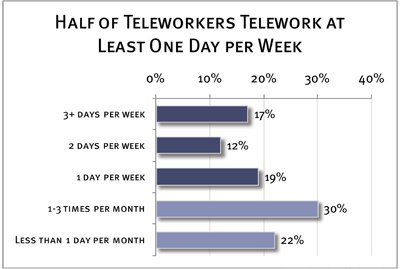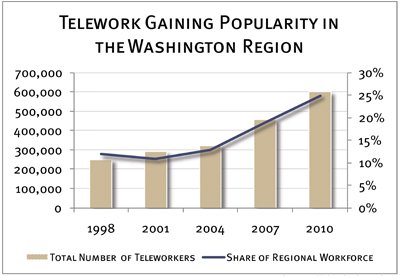More than 600,000 people in the Washington region telework "at least occasionally" and another 500,000 say they "could and would" work remotely if given the opportunity, according to the results of a 2010 Transportation Planning Board survey of commuters' travel patterns. That's nearly half of the region's 2010 workforce of around 2.4 million people.
Of the 600,000 people already teleworking, about half did so at least one day a week, according to the survey, which is conducted every three years. Seventeen percent reported teleworking three or more days per week. The average frequency was 1.3 days per week.
|

Source: 2010 TPB State of the Commute Survey
|
All together, more than 200,000 peak period commuting trips were taken off of crowded roads on any given weekday in 2010 thanks to telecommuting, resulting in 4.1 million fewer vehicle miles of travel per day, and annual emissions reductions of more than 1,100 tons of smog-forming pollutants and 527,000 tons of carbon dioxide.
Teleworking has been gaining in popularity in the Washington region for more than a decade: the share of the workforce that reported working from home or working remotely at least occasionally doubled between 1998 and 2010, from 12% of the workforce to 25%, according to the survey.
|

Source: 2010 TPB State of the Commute Survey
|
Most recently -- between the 2007 and 2010 surveys -- the federal agencies in the region posted the biggest gains in the share of their workforce that was teleworking, jumping from 16% to 27%.
That increase brought the share of federal employees in the region who telework in line with the shares of the private sector and non-profit workforce who work remotely. About half as many people in state and local government agencies in the region telework -- around 13% as of 2010 -- due mainly to the in-person nature of the work that many local government agency employees need to perform.
The TPB has been involved since the late 1980s in studying the impacts of and potential for teleworking in the Washington region, and since the mid-1990s has proactively promoted teleworking as a way to reduce congestion and improve the region's air quality.
Reviews of telework pilot programs in Los Angeles, California, and in Arlington County, Virginia, and monitoring of the federal "Flexiplace Program" and state-level telework initiatives in Virginia and Maryland were the subject of the TPB's earliest telework-related efforts in the late 1980s.
In 1996, the TPB launched an aggressive outreach campaign through its Commuter Connections program to educate the business community and the general public about the benefits of teleworking.
That work included developing "how-to" kits and instructional videos for employers and employees, as well as annual telework seminars for employers to talk about the challenges of employee supervision and accountability, managing relations between workers who are allowed to telework and those who aren't, and the technological obstacles to expanding telework opportunities.
Today, Commuter Connections promotes teleworking as part of the broader package of alternatives to driving alone to and from work, and provides online telework resources for commuters and employers, including employer case studies and a dedicated Facebook page for collaborative discussions on current telework issues.
Commuter Connections also supports local jurisdiction telework efforts by providing on-call assistance to employers interested in starting or expanding telework programs.
As technology continues to advance -- providing easier, cheaper, more reliable ways to work remotely -- more people are likely to be able to telework, and those who do may well be able to telework more often.
Employer flexibility is also expected to continue to increase as teleworking comes to be seen as a more necessary tool in attracting and retaining talented workers who are seeking ways to balance the demands of work and life and to ease the burden of daily commuting.
The TPB's next survey of the daily commuting patterns of the region's workforce, scheduled for next year, will show whether teleworking has continued to grow since 2010 and might suggest what the future of teleworking in the region will look like.
Related Links